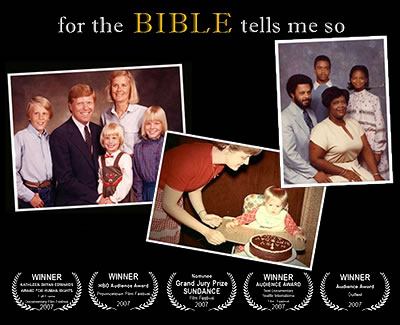Review | Brian Masefield
For the Bible Tells Me So (2007) is a film that explores the intersection between religion and homosexuality in the U.S. and how the religious right has used its interpretation of the Bible to stigmatize the gay community.
What’s Up, Doc? Revisiting For the Bible Tells Me So:
I live in New York City, and I’m married to a man. We have a nice life, my husband and I. We have solid jobs, a great circle of friends, and a washer and dryer. We have our little struggles. We worry about our aging parents, bicker over the virtues of Reality TV, and wonder if our cat is truly happy. We’re allowed the luxuries of these niceties and tiny worries in part because we’re allowed to openly be who we are. We’re lucky enough to live in a state where we can marry one another, and just live our lives. My friends and I often talk about living in “the bubble of New York City.” My husband and I even got married ten minutes down the street from where we live.
“We’re so lucky to live in New York,” I thought on our wedding day at Brooklyn’s City Clerk’s office. Watching the documentary For the Bible Tells Me So reminds me of our luck.
Initially released in 2007, Bible follows the lives of five families, all from “the South” or, at least, religiously conservative. The doc recounts the journeys these families faced after a member of their tribe came out of the closet. Though nearly seven years old, the film feels as fresh and timely as ever, particularly in our age of possible DOMA and Prop8 repeals.
Beginning with the iconic pie-bombing of gay-opponent Anita Bryant, Bible dishes out a big helping of hate-filled clips, clearly setting up ‘the enemy.’
“God hates this country,” shouts an angry white male, concluding his quick commentary on the ‘abomination’ that is homosexuality.
Both the pie-bomb and the shouting occur in the first ninety seconds of Bible, yet the overall film is not as hostile in its tone. (The closest it comes to reclaiming this level of hostility is much later, during some overly-dramatic voiceover readings of hate mail received by one its subjects.)
The families featured in Bible each have a quiet power. The heads of each clan carefully set the stage of the upcoming gay reveal, defining what their belief in God means to them. In each case it means a great deal, with parents being church-going folk, or US Presidential hopefuls. (Dick Gephardt and his daughter Chrissy are among the film’s subjects.)
What struck me most while watching Bible, was the shocking difference in communication styles used by the harried parents and their freshly-out offspring. The parents permeate a conflicted, emotional cadence, still sounding as raw and vulnerable as the day their lives were thrown gay curveballs. Their adult gay children, on the other hand, are straightforward, realistic and methodical. (In one scene, an Ivy League lesbian calmly recounts missing the close, honest bond she once had with her mom, now sullied by her gay reveal. The scene ends with her puzzled mom saying, “We gonna fix this.”)
These sequences, the actual “coming out” stories, have a riveting, organic momentum. So much so, that it left me wishing the filmmakers had calmed down a bit on the ultra-quick editing and excessive uses of stock footage in the first half of the doc. It’s as if they felt they needed to appease an attention-deficient MTV generation, relentlessly flashing new clips over people’s stories. Particularly in the beginning of the film, I don’t recall a single camera shot that lasted more than ten seconds. The film could’ve been even more powerful, and certainly more personable, if the subjects were given some real face time.
Another misfire? As many documentaries have done before and since, Bible plops a four-minute animated sequence right in the middle of the film. The cartoon discusses the science of homosexuality, complete with two stereotypical gay characters, “George” and “Martha”. The animated bit actually provides some interesting facts (the more sons a mother gives birth to, the higher the chance that each coming son with be gay), yet it’s in such stark contrast to rest of film’s style, you can’t help but question if it’s just too quirky for its own good.
Thankfully, the film gets back on track after the cartoon in a big way, tackling specific biblical passages. Give the film big kudos for not taking cheap shots at the naysayers of homosexuality. On the contrary, the film presents its negating facts to religious opinion without any smarm, sarcasm or Dan Savage-style righteousness many contemporaries use nowadays. Even in its most condemning points, like the Bible’s claim that eating rabbit – like homosexuality – is an abomination, are presented with a calm, respectful smile.
The final chapters of Bible quickly culminate into some lovely tear-jerking scenes by daring to provide efficient happy endings for all involved, even for a parent whose gay child has committed suicide. Each story ties itself up with a sense of understanding and, in some cases, acts of extreme social activism. It does feel rushed, but it never feels cheap.
For the Bible Tells Me So can still stand proudly with some of the finest LGBT documentaries out there. After a frantic first half, the film allows itself to breathe and tells its stories. In those tales, we witness the arcs of religious beliefs, the importance of acceptance, and the enduring faith in humanity.
Follow Brian on Twitter: @brianmasefield

